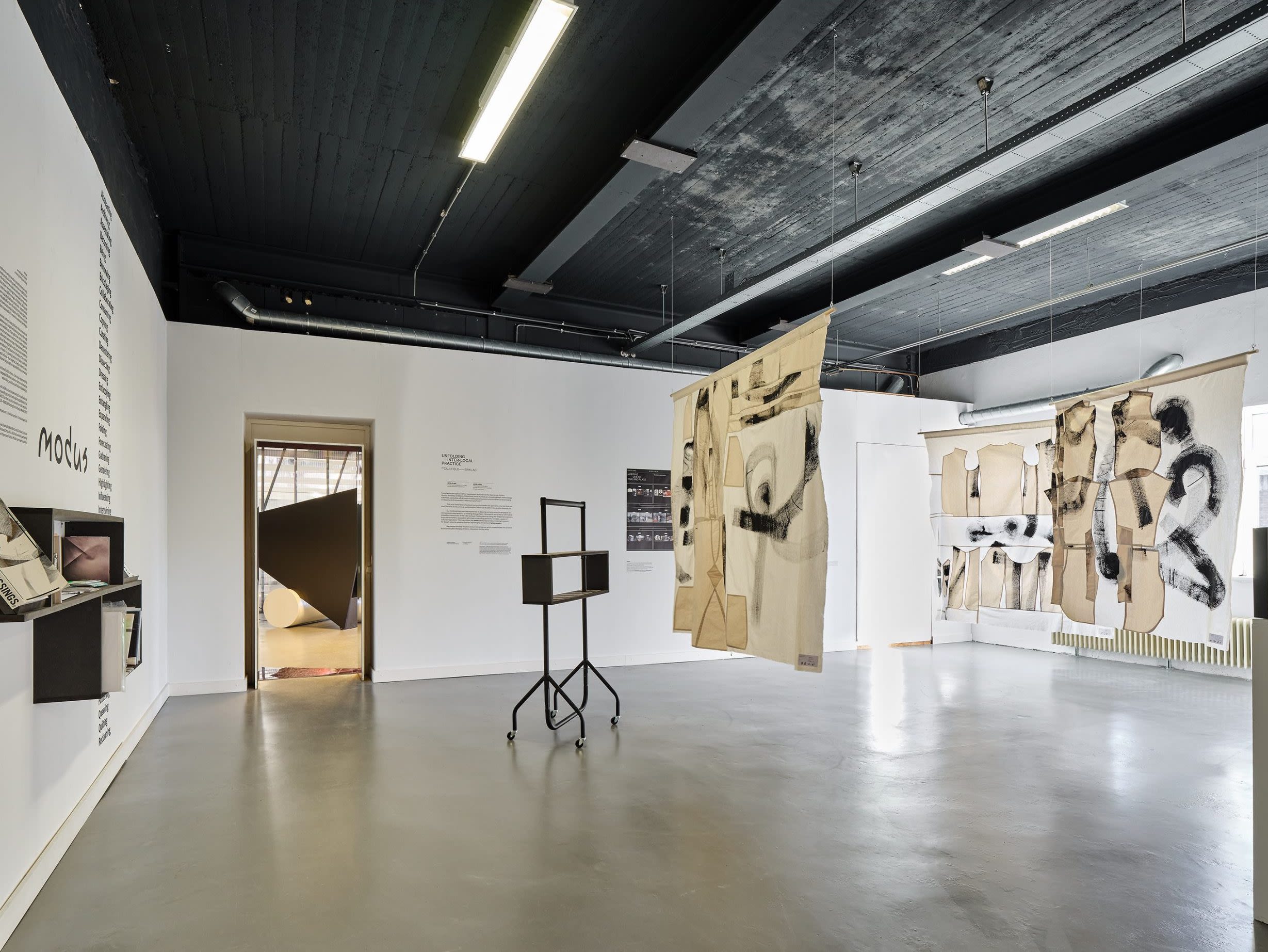Celebrating a Sense of Belonging through Expanded Fashion Practice

- Written byCentre for Fashion Curation
- Published date 10 January 2022

MODUS and CAULFIELD—SRIKLAD in conversation with Professor Amy de la Haye
Professor Amy de la Haye from the Centre for Fashion Curation recently hosted an online ‘in conversation’ between expanded fashion platform MODUS and studio practice CAULFIELD—SRIKLAD.
Together they discussed a recent exhibition titled ‘MODUS Hosts: Unfolding Inter-local Practice’, which opened during Dutch Design Week 2021 at Onomatopee Projects in Eindhoven, NL. Through the discussion, they explored how this exhibition illustrates expanded fashion practice using a range of disciplines from curation, graphic design, academic theory, moving image and fashion design, suggesting new ways of thinking, being and doing fashion.
Within the exhibition CAULFIELD—SRIKLAD shared their emergent embodied and ‘inter-local’ design methodology, which explores the process of belonging to hybrid and in-between states of being. During the online discussion, Daniel and Siranee Caulfield-Sriklad explained how being from two cultures, Thai and Irish, challenged and raised questions around their own sense of belonging. In response, they have used their practice to find resolution and liberation through belonging to what they call an ‘inter-place’ i.e. the union and integration of multiple places that shape experience.
See below for some highlights of the discussion.

Amy de la Haye: Through your work, you’ve not only used dress as evidence of lives lived using garments from your family archive, but you have also used these methods to generate greater meaning in your own lives today.
Daniel Caulfield-Sriklad: Creating this work was a real opportunity to play with time. Spending time within our own family archives enabled a sense of playing with time past, present and future. We have been specifically looking into contrasting dressing practices within our family lineage. Our great grandfather was an Irish suit tailor and our father was a former Thai Theravada Buddhist Monk. We have used various processes for re-imagining our archives, from montage and collage to actually dressing in culturally significant garments worn by our grandparents and parents. This process allows for an embodied sense of cultural imagination, re-imaging, re-dressing and ultimately, re-imagining our relationship with the past to inform a new sense of our own cultural identity moving forward. Through the process of making this work, we have gained a great sense of agency over our own cultural identity.

Ruby Hoette (MODUS): I was struck by how you mentioned that the discovery of an expanded fashion practice was a liberating discovery, as it offers a way to be able to work without the pressure of an outcome or final product. Why is it important for fashion practice in particular to not focus on a final product or outcome? What does that allow for?
Siranee Caulfield-Sriklad: It allows us to see the beauty and meaning within the story and that enables so much potential. I feel the outcomes rarely do the stories justice and I've always felt that was such a shame. When I would watch my peers present their work during my time at university, I was always so fascinated by the stories that informed the outcome. The process really does emphasise meaning, it creates stories and creates space to connect with those stories and that is really important. That is why the process holds such value for us in our practice.
Caroline Stevenson (MODUS): I’m really intrigued by the language that you are using to talk about your process and practice. It seems to draw on the history of conceptual art, graphic design and fashion-making. In terms of defining an expanded fashion practice I think it is incredible to be able to articulate those things so well and to know your own process and methods so well.
In addition, through your work you have consciously created a space for the ‘perpetual foreigner’, and I wonder if inhabiting and finding comfort in these spaces that are between and at the edges of, feels like a familiar or comfortable place to locate a practice?
Siranee Caulfield-Sriklad: Yes absolutely. Our process was very therapeutic in a way, through these methods we have responded to our own struggles with our identity and our own sense of belonging. We engaged a range of disciplines: fashion, graphics, art, to help us deepen our relationship with ourselves. These spaces that are ‘between’ and ‘at the edges of’ have gifted us an important confidence in a new ‘inter-local’ sense of belonging.

Daniel Caulfield-Sriklad: The terms ‘inter-place’ and ‘inter-local’ are also not only about place-based belonging. Beyond geographical notions of belonging, we all experience belonging to ‘in-between’ states of our subject positions whether that be our relationship with gender, sexuality, ethnicity for example. Through our studio practice we are bringing consciousness to those in-between spaces or ‘inter-places’. Ultimately, it is through the process of belonging to these non-fixed, hybrid states of being that we make ourselves local, for us this is what it means to be inter-local. Moving forward, we are continuing to create work that promotes our embodied and inter-local design methodology through expanded fashion practice.
Follow CAULFIELD—SRIKLAD on Instagram: @caulfieldsriklad
Explore the MODUS platform: https://modus.onomatopee.net/
Follow MODUS on Instagram: @modus.project
Images courtesy of Modus/Caulfield-Sriklad
MODUS Hosts: Unfolding Inter-local Practice’ received research and development funding from the Centre for Fashion Curation, supporting new methods for and expanded fashion practice.